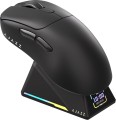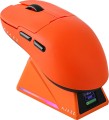Cable length
The length of the cable that is equipped with a mouse with the possibility of a wired connection (see "Type of connection").
When choosing this parameter, you should first of all take into account the distance from the manipulator to the connection port: a cable that is too short may simply not reach the connector, and a cable that is too long may get tangled at hand and create inconvenience. As for specific values, the most modest wire length in modern mice is
1 m or less ; such devices are intended mainly for laptops. Most desktop manipulators come with cables that
are 1.1-1.5m or
1.6-2m long, with some models running
longer than 2m.
Sensor resolution
Resolution of the sensor responsible for tracking mouse movements on the work surface. Specified in DPI — dots per inch.
The physical meaning of DPI as a whole is as follows. The sensor of a modern mouse works on the same principle as the camera matrix, and consists of pixels. And DPI is the number of pixels that fall on 1 inch of the underlying surface (length or width), "visible" by the sensor.
It is believed that more DPI means a more advanced sensor and mouse in general; nowadays, models for
3500 – 5000 DPI,
12000 DPI,
16000 DPI even
more are not uncommon. In a way, it is — high resolution contributes to accuracy. However, the only thing that is directly determined by this indicator is the speed at which the cursor moves across the screen: the higher the resolution of the sensor, the greater the number of pixels that the cursor will move when the mouse itself moves a certain distance. At the same time, it is worth recalling that too high a speed is even more undesirable than too low. So the real need for high DPI (
1000 and above) arises mainly when working on large screens (4K resolution and more); for more modest displays (HD and Full HD), smaller values are often enough.
Max. speed
The ips (inches per second) parameter is the linear speed of mouse movement, expressed in inches per second, at which the manipulator's sensor is able to read the surface. In top models, the maximum mouse movement speed often reaches 400-600 ips, but devices with ips in the region of 200 are more common.
Number of buttons
The number of buttons provided in the design of the mouse. However, the term "buttons" can also refer to specific hardware solutions — for example, a solid touch area used in many Apple mice counts as two buttons, because. it is divided into two working areas. But the clickable wheels, as well as the power button, are not taken into account in this calculation.
The minimum number of buttons for modern mice and other similar manipulators is
two : this is the number that is necessary for comfortable work in most modern operating systems. If there are more than two keys, this means that there are additional buttons responsible for specific actions. So, even relatively inexpensive devices can be equipped with
3 – 4 buttons ; in addition to the 2 main buttons, they can have, for example, 2 side thumb keys, or 1 double/triple click button (see below). Solutions for
5 – 6 buttons are extremely popular nowadays; among them are many gaming mice, where the mentioned thumb buttons are supplemented with a double / triple click, a sniper button and/or a DPI switch (see also below about these functions). And in the most multifunctional models,
7 – 8 buttons and even
more can be installed. In some cases, this number exceeds a dozen and a half; such mice are usually gaming devices designed for RPGs and other simil
...ar genres where it is important to have a wide range of actions at your fingertips.Switch resource
The durability of mouse switches is measured by the number of clicks the keys can withstand before they begin to show signs of wear or malfunction. Switches can have a lifespan of several million to tens of millions of clicks. In laboratory conditions, this parameter is checked using special testing machines, which diligently press the keys the required number of times, on the basis of which a verdict is made regarding the approximate service life of the switches.
Programmable buttons
The presence
of programmable buttons in the design of the mouse. In this case, the buttons mean not only the keys, but also the scroll wheels, which are usually able to work on pressure.
Almost all models with this feature are gaming (see "By Direction"). Usually, programming is carried out using special proprietary software, while the functionality of such a setting may be different. For example, in some models, only one action can be tied to one button, in others — a whole series of actions (such as a combination of attacks in an RPG). Often, it is possible to configure one button for different actions in different games.
However, this feature provides an additional convenience: the mouse keys are right at hand, and it is usually easier (and faster) to use them than to reach for the button (s) on the keyboard.
Battery capacity
The battery capacity in a mouse affects how long it can operate without recharging and determines how often the device will need to be charged. Although manufacturers usually specify the operating time, the capacity helps assess the battery's resource under intensive use or when additional features, such as backlighting, are activated.
In box
— USB receiver. A device that is found only in models with wireless connectivity. Such a receiver is connected to the USB port of a computer or laptop, and communication is carried out through it. This is the way all mice with a radio connection work, for them the presence of a USB receiver in the kit is almost mandatory. At the same time, this accessory is also found in the Bluetooth model — in them it plays the role of an adapter for equipment that is not equipped with its own Bluetooth modules.
—
Replaceable legs. Legs are small protrusions on the bottom surface of the case, on which the mouse rests, standing on the work surface. They reduce resistance, allowing the device to slide freely in any direction, and also compensate for minor irregularities to a certain extent. However, due to constant friction, the legs are subject to heavy wear, over time they wear out or may come off. Thus, modern mice may come with interchangeable legs; such a complete set means that regular overlays can be easily removed by the user.
—
Interchangeable side panels. A feature found primarily in game models (see "By Direction"). At the same time, the purpose of removable panels can be different. So, in some models, they are used to fine-tune the width or overall shape to the user's hand. In other devices, rearranging the panel allows you to change the functionality — for example, install four side button
...s instead of two, providing additional features in games (and return the panel with two classic side buttons back while surfing the Internet and other everyday tasks). Such nuances should be clarified in each case separately.
— Replaceable top panels. Additional components that can be installed in place of the standard top of the mouse to change its appearance or ergonomics. Their support is implemented in some models of gaming mice (see “Direction”). Replaceable top panels provide the ability to customize the mouse to suit individual ergonomic preferences, and they also serve as a stylistic element in the design of the manipulator.
— Rug. Mice that use the mouse pad as a power source are required (see "Power"), but this accessory can also be supplied with more traditional models. In the latter case, it is worth clarifying what material the pad is made of, what dimensions and design features it has — these points may not meet the user's requirements, in many cases it is more convenient to buy an underarm pad separately.
— Case. The cover will be appropriate if you need to regularly move the mouse from place to place (for example, for frequent competitions or with a work laptop). In a protective case, your “rodent” will not be afraid of external damage to which a mouse can be subjected even while in the personal compartment of a backpack.
— Additional switches (mics) — for example, spare switches of the same type as regular ones, or interchangeable ones that differ in characteristics.
— Interchangeable side buttons. Separate side buttons that can replace regular ones. These may be keys of a different shape or spare parts of a similar design.
— Stickers. Decorative stickers that allow you to personalize your device, giving it an original look.
— Additional cable. A replacement wire that differs from the main one in length and/or other characteristics (for example, the presence / absence of a braid).
— Headphones. Gaming computer headphones supplied with mice of the corresponding specialization (see "By Direction").
